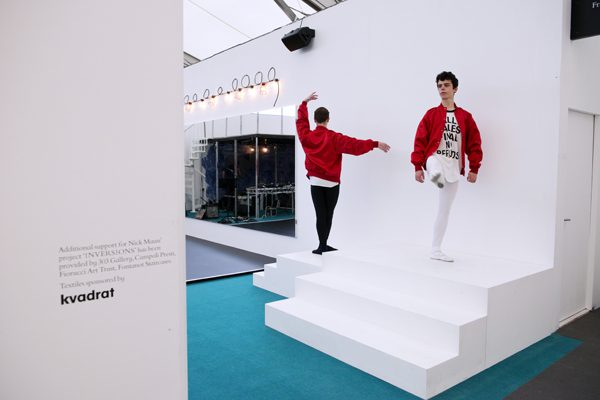Like some sort of spandex-clad somersaulter often found in the medium itself, performance art has, in recent years, acrobatically risen to become the red-hot property in today’s contemporary art world. Ever since the mid-1960s, the likes of Yves Klein and Yoko Ono have been utilising the experimental and anti-commodity form to evoke radical messages and go against the commercial gallery grain. But nowadays, performance art is very much the toast of the establishment; in some cases for the better, and some for the worse.
In 2014 alone, Marina Abramović brought a new blockbusting piece to London’s Serpentine Gallery, following her bewitching 2010 MoMA New York show The Artist is Present; Art Basel’s 14 Rooms Exhibition introduced a new “live art” section featuring work from stalwarts such as Damien Hirst; whereas, the ongoing Mirrorcity exhibition at London’s Hayward Gallery will feature a series of performances – such as, Lloyd Corporation’s “street vendor” and “sign holder” living statues – to compliment the more traditional artistic mediums on offer. Then, of course, there is Frieze Art Fair, one of the undoubted highlights of the country’s – if not the world’s – art calendar, which itself is reflecting the shift towards performance.
As part of Frieze Projects, a Live section has been welcomed to the 12th edition of the world-renowned fair, which includes both works specifically commissioned by the fair, as well as the restaging of historical pieces. Out of six galleries that have been selected for the Live section (from a pool of over 100 pitches), two are re-stagings: Jocelyn Wolff gallery are showing Franz Erhard Walther’s minimalistic action-sculpture works, while gb agency are showing Robert Breer’s Floats, which was originally made for the 1970 World’s Fair in Osaka.
The newer performance works at Frieze Live, however, certainly aren’t lacking when it comes to experimentation and radicalism either. For their piece Does This Soup Taste Ambivalent? (2014), the Japanese artist duo United Brothers are offering visitors a soup made of vegetables grown in the region of Fukushima’s 2011 nuclear disaster. “We wanted to present a choice that we people from Fukushima have to make every day,” explains one of the brothers, Ei Arakawa. “I know that even though the vegetables aren’t really contaminated, it is still a psychological choice.”
Elsewhere, Jérôme Bel, the French artist-cum-choreographer, is bringing his Disabled Theatre (2012) to the UK for the first time, after sparking controversy at Documenta 13 in 2012. Featuring a professional Swiss acting company, whose members all are with learning difficulties, it is undoubtedly engrossing. Nick Mauss has brought a “living stage” to the fair, which offers a new ballet, yet equally immersive each day. The Welsh artist Cerith Wyn Evans will install a work at Frieze’s neighbours London Zoo, a place he regularly visits, between the aviary and the African dogs enclosure. Meanwhile, artist Jonathan Berger is presenting a series of Andy Kaufman-related pieces, including a daily orchestra performance of an overture, now lost, that was once performed at Kaufman’s Carnegie Hall concert of 1979.
In part, the performance art phenomenon has been propelled by a new generation of artists such as Tino Sehgal and Eddie Peake. Plus there’s the influence of heavyweight galleries: Tate Modern opened The Tanks in 2012, revealing a temporary space to showcase performance. But it shouldn’t be forgotten that while in the past the Frieze Foundation has sponsored performance-related works as part of the Frieze Projects programme, these have been non-selling events. At Frieze Live, everything that is staged by galleries in the fair can be purchased, and at no little price: Lisson gallery, for example, are selling films and photos of Marina Abramovic performances for between £100,000 and £200,000.
Nonetheless, Frieze Art Fair was never a place to land a bargain. That won’t change. What has changed – thanks to Frieze Projects curator Nicola Lees – is the mood and experience at Frieze 2014. It is a playfully-curated year, but also one that is, at times, surprisingly experimental and pleasingly fresh.
Frieze London, until 18 October, Regent’s Park, London.
Peter Yeung
Credits
1. Nick Mauss – Frieze.





